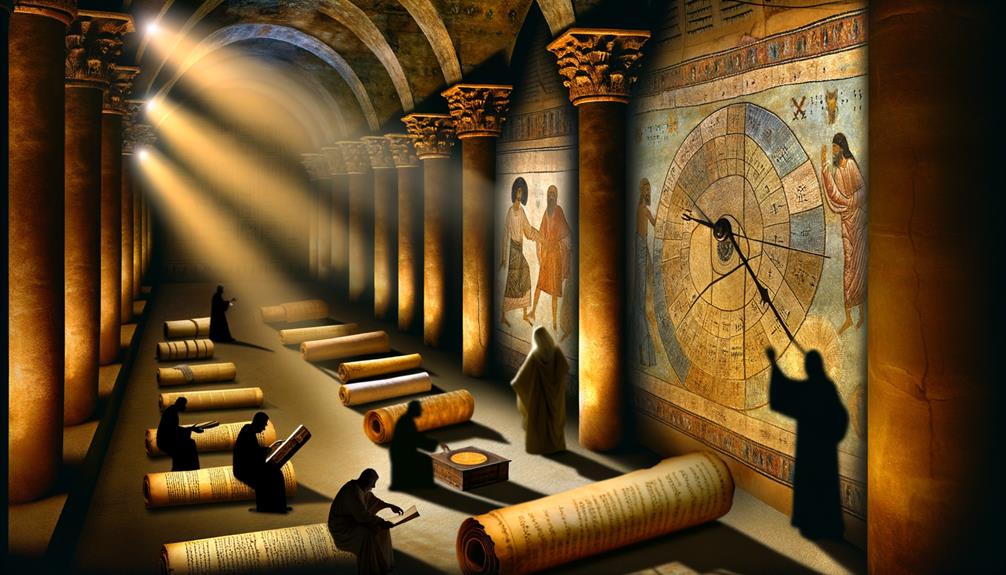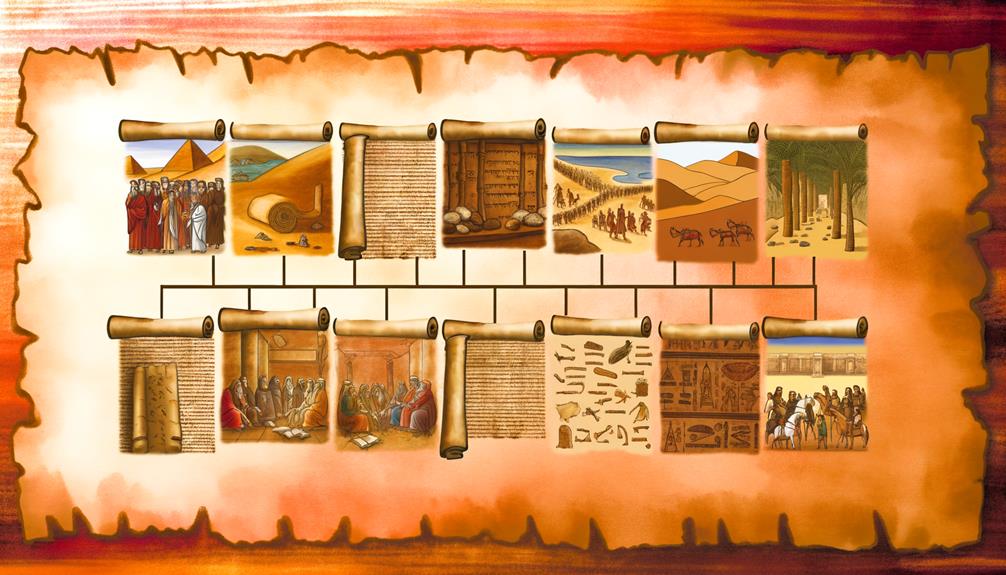Meaning of BCE in the Bible: Historical Timeline
In biblical studies, BCE stands for ‘Before Common Era‘ and is used as a secular alternative to ‘Before Christ’ (BC). This terminology emerged in the early 17th century, reflecting efforts to create an inclusive chronological framework that accommodates diverse religious and cultural contexts.
The change from BC to BCE signals a shift towards minimizing Christian-centric bias, providing a universal and neutral timeline for historical events. Scholars favor BCE for its precision and inclusivity, facilitating clearer historical analysis and archaeological alignment.
Exploring the adoption of BCE reveals its impact on biblical scholarship and broader interfaith dialogues.

Meaning of BCE in the Bible: Historical Context and Usage Explained
| Aspect | Meaning |
|---|---|
| Term | BCE – Before Common Era |
| Equivalent To | BC – Before Christ |
| Usage in Bible Studies | Used to date events before the birth of Jesus Christ |
| Modern Adoption | Preferred in academic and interfaith contexts for neutrality |
| Biblical Relevance | Helps place Old Testament and ancient history in a clear timeline |
| Faith Insight | Though secular in form, still points to Christ as the pivotal figure in history |
Definition of BCE

The term BCE, which stands for ‘Before Common Era,’ is a secular alternative to the traditionally used BC (‘Before Christ’) in historical and theological contexts. This terminology emerged as a neutral, culturally inclusive way to reference historical dates without specific religious connotations.
In biblical scholarship, BCE is used to denote periods before the estimated birth year of Jesus Christ, aligning with the Gregorian calendar. This notation is particularly useful in interfaith and academic dialogues where neutrality and inclusivity are paramount.
Origin of BCE Terminology

Adoption of the BCE terminology can be traced back to the early 17th century when scholars sought a more inclusive and secular way to date historical events. This shift emerged primarily among academic circles aiming to create a universal dating system that transcended Christian-centric frameworks.
Theologically, this was significant as it allowed for a more unbiased interpretation of historical texts, including the Bible. Historically, BCE (Before Common Era) provided a neutral alternative to BC (Before Christ), reflecting a broader, more global perspective.
The terminology aligns with the Common Era (CE), ensuring consistency while respecting diverse religious and cultural backgrounds. Consequently, the early adoption of BCE signified an important evolution in the scholarly approach to chronology and historiography.
BCE Vs. BC

The distinction between BCE (Before Common Era) and BC (Before Christ) is rooted in both historical context and religious sensitivity.
BCE is often favored for its secular and inclusive approach, aiming to provide a neutral chronological framework that transcends specific religious connotations.
This shift from BC to BCE reflects broader societal values of inclusivity and respect for diverse cultural and religious perspectives.
Historical Context Differences
Understanding the historical context differences between BCE (Before Common Era) and BC (Before Christ) illuminates the evolution of chronological terminology in biblical scholarship. This shift reflects broader changes in academic and theological perspectives.
BC is rooted in Christian tradition, dating events relative to the birth of Jesus Christ. Conversely, BCE is a secular alternative that maintains identical chronological placement but excludes religious connotations, aligning with modern, inclusive scholarship.
| Aspect | BCE (Before Common Era) | BC (Before Christ) |
|---|---|---|
| Origin | Secular Scholarship | Christian Tradition |
| Cultural Neutrality | High | Low |
| Chronological Same | Yes | Yes |
This nuanced understanding aids in comprehending how historical narratives are framed within varying scholarly and theological contexts.
Religious Neutrality Debate
Debating the use of BCE versus BC in scholarly and theological contexts often centers on the quest for religious neutrality and inclusivity in chronological terminology.
Historically, ‘BC’ (Before Christ) and ‘AD’ (Anno Domini) are rooted in Christian tradition, aligning the calendar with the birth of Jesus Christ.
However, ‘BCE’ (Before Common Era) and ‘CE’ (Common Era) have been adopted to foster a more universal, non-religious framework for historical dating.
Theologically, some argue that BCE/CE diminishes the Christocentric nature of history, while others advocate for its use to respect diverse religious and cultural backgrounds.
This debate reflects broader conversations about inclusivity, aiming to balance respect for religious traditions with the need for a global, secular scholarly standard.
Historical Context

In examining the historical context of BCE in biblical literature, it is essential to contemplate the chronological frameworks employed by ancient civilizations.
Prior to the Common Era (BCE), societies such as the Egyptians, Babylonians, and Israelites utilized diverse calendrical systems based on lunar and solar cycles.
The Hebrew Bible itself reflects these varying temporal references, often synchronizing events with the reigns of kings or significant historical milestones.
Understanding the usage of BCE provides modern readers with a clearer perspective on the temporal setting of biblical narratives.
This chronological marker allows for a more precise alignment of biblical events with archaeological findings and historical records, enhancing our comprehension of the ancient world and its enduring theological legacies.
Cultural Inclusivity

Cultural inclusivity within the biblical context underscores the integration and interaction of diverse ethnic and social groups, reflecting the broader ancient Near Eastern milieu.
This is evident in various biblical narratives where different cultures and peoples intermingled, influencing religious, social, and political dynamics. The inclusion of foreign individuals and nations in biblical stories highlights a theological message of universalism and inclusivity.
| Culture/Group | Biblical Reference |
|---|---|
| Egyptians | Exodus, Joseph’s Story |
| Canaanites | Joshua, Judges |
| Babylonians | Book of Daniel |
| Persians | Book of Esther, Isaiah |
| Greeks | Influence during Hellenistic Period |
These interactions emphasize the Bible’s complex cultural landscape, urging modern readers to appreciate the text’s historical and cultural depth.
Secular Vs. Religious
The term BCE, standing for ‘Before Common Era,’ exemplifies the intersection of historical dating methods and the tension between secular and religious perspectives.
While academic circles often adopt BCE to maintain a neutral stance, theological interpretations may prefer BC, ‘Before Christ,’ to emphasize religious significance.
This dichotomy underscores the broader debate between secular historiography and religious belief systems in the interpretation of ancient texts.
Historical Dating Methods
Contrasting secular and religious historical dating methods reveals significant differences in how each tradition interprets and values chronological evidence.
Secular methods, including radiocarbon dating, dendrochronology, and stratigraphy, emphasize empirical data and scientific analysis to establish timelines. These methods aim for objectivity and reproducibility, forming the bedrock of academic history.
In contrast, religious dating often relies on scriptural texts, traditions, and theological interpretations to construct historical narratives. For instance, biblical chronology frequently uses genealogies and prophetic timelines to date events.
While secular methods prioritize physical evidence and cross-disciplinary corroboration, religious methods emphasize faith-based sources and doctrinal consistency.
This divergence underscores the broader epistemological differences between scientific inquiry and religious belief, each offering unique insights into human history.
Interpretations and Beliefs
In examining the interpretations and beliefs surrounding historical timelines, one finds that secular and religious perspectives often diverge markedly in their foundational assumptions and methodologies.
Secular approaches typically rely on empirical evidence and scientific methods, whereas religious interpretations are grounded in theological doctrines and scriptural texts. These differences manifest in various ways:
- Historical Accuracy: Secular historians prioritize archaeological and textual evidence.
- Faith-Based Chronology: Religious scholars may align timelines with doctrinal events.
- Terminology: Secular use of BCE (Before Common Era) contrasts with BC (Before Christ) in religious contexts.
- Interpretive Framework: Secular interpretations are generally more flexible, whereas religious views adhere to specific theological frameworks.
This divergence underscores the complexity of reconciling different worldviews.
Academic Versus Theological
Academic and theological perspectives on historical timelines often reveal deep-seated differences rooted in their respective methodologies and foundational premises.
Academically, BCE (Before Common Era) is utilized to offer a neutral, inclusive chronological framework, devoid of religious connotations, aligning with the CE (Common Era) terminology. In contrast, theological viewpoints traditionally employ BC (Before Christ) and AD (Anno Domini), reflecting a Christ-centric temporal division.
This divergence underscores a broader debate: while academics prioritize empirical evidence and secular inclusivity, theological interpretations emphasize faith-based historical chronology.
This dichotomy generates distinct understandings of biblical events and their respective datings, revealing the interplay between secular scholarship and religious tradition in framing historical narratives.
Understanding these perspectives enriches the discourse on biblical history.
Dating Biblical Events

Dating biblical events requires a meticulous examination of historical records, archaeological findings, and scriptural narratives to establish a coherent timeline. Scholars engage in a multidisciplinary approach to verify the chronology of events described in the Bible.
This involves:
- Historical Records: Cross-referencing ancient manuscripts and inscriptions.
- Archaeological Findings: Unearthing artifacts that correlate with biblical accounts.
- Astronomical Data: Utilizing celestial events described in scriptures to pinpoint dates.
- Textual Analysis: Studying linguistic and contextual clues within the Bible.
These methods collectively enhance our understanding of the Bible’s historical context, providing a more nuanced perspective on its narratives and the periods they describe.
This rigorous analysis aids theologians and historians in discerning the Bible’s temporal landscape.
Academic Adoption

The academic adoption of BCE (Before Common Era) terminology reflects a broader scholarly consensus aimed at fostering inclusivity and precision in historical dating.
This shift also invites theological reflection on how chronological designations intersect with religious narratives.
Consequently, the usage of BCE has become prevalent in religious studies, balancing respect for diverse traditions with the need for a standardized academic framework.
Scholarly Consensus on BCE
Recognizing the need for a neutral and inclusive chronological framework, scholars across various academic disciplines have largely adopted the term BCE (Before Common Era) in place of the traditionally Christian-centric BC (Before Christ).
This shift reflects a broader academic commitment to inclusivity and precision in historical analysis. The use of BCE is prevalent in theological studies, historical research, and archaeological documentation.
- Neutrality: Removes religious bias from historical dating.
- Inclusivity: Accommodates diverse religious and cultural perspectives.
- Standardization: Aligns with the CE (Common Era) system, ensuring consistency.
- Academic Integrity: Reflects scholarly commitment to objectivity.
This consensus provides a more universally accessible method for chronological reference.
Theological Implications Considered
How does the academic adoption of BCE affect theological interpretations and the traditional understanding of biblical chronology?
The shift from BC (Before Christ) to BCE (Before Common Era) introduces a more secular framework for historical analysis, distancing religious connotations. This change encourages a re-evaluation of biblical events within broader historical contexts, emphasizing universal timelines over specifically Christian ones.
Theologically, this can challenge traditional interpretations that rely on a Christocentric chronology, potentially altering the perceived divine orchestration of historical events. Additionally, it fosters interfaith dialogue by adopting a more inclusive terminology, yet it may also provoke resistance among those who view the change as diminishing the sacred narrative’s uniqueness.
Ultimately, the adoption of BCE underscores the intersection of faith and academic rigor.
Usage in Religious Studies
In academic religious studies, the adoption of BCE (Before Common Era) terminology critically reshapes the framework through which biblical chronology is examined. This shift aligns scholarly discourse with a more inclusive and secular lexicon, fostering interfaith and interdisciplinary dialogue.
Theological and historical analyses benefit from this terminology, as it:
- Promotes Neutrality: Reduces religious bias in academic writing.
- Encourages Inclusivity: Guarantees respect for diverse faith traditions.
- Facilitates Comparative Studies: Enhances the ability to compare biblical events with other historical timelines.
- Standardizes Academic Language: Creates uniformity in scholarly discussions.
Global Acceptance

The shift from the traditional ‘BC’ (Before Christ) to ‘BCE’ (Before Common Era) has steadily gained global acceptance, reflecting a broader cultural and religious inclusivity in historical dating.
This change underscores a movement towards a more neutral and secular terminology, minimizing the Christian-centric bias inherent in ‘BC’.
Historically, this alteration aligns with efforts to foster global academic collaboration and respect for diverse religious traditions.
Theologically, ‘BCE’ allows for a more inclusive approach to historical chronology, accommodating scholars and adherents of various faiths.
The adoption of ‘BCE’ by prominent educational institutions and international bodies signifies its growing acceptance, reinforcing a commitment to a more universally understandable and culturally sensitive framework for historical reference.
Impact on Biblical Studies

This burgeoning acceptance of ‘BCE’ over ‘BC’ greatly influences biblical studies, offering a more inclusive framework that respects the diverse religious perspectives of scholars and students.
This terminological shift has several significant implications:
- Inclusivity: It allows non-Christian scholars to engage with biblical texts without the implicit Christian bias of ‘BC’.
- Academic Neutrality: Promotes a more secular approach, aligning with broader historical and archaeological scholarship.
- Interfaith Dialogue: Facilitates conversations among scholars of various faiths, promoting mutual respect and understanding.
- Pedagogical Clarity: Simplifies teaching and learning by using a neutral term that is less likely to alienate students of different backgrounds.
This analytical, historical, and theological shift underscores the evolving nature of biblical studies.
Future of BCE

As the academic community continues to embrace the term ‘BCE‘, its future seems promising in fostering a more inclusive and precise framework for biblical chronology and historical analysis.
This shift towards ‘BCE’—Before Common Era—allows scholars to transcend religious boundaries, promoting a universally accessible timeline.
Theologically, this neutrality guarantees that interpretations of biblical events are based on historical evidence rather than doctrinal bias.
Historically, the use of ‘BCE’ aligns biblical events with global history, offering a coherent narrative that integrates diverse cultures and epochs.
Conclusion
The evolution of BCE terminology, emerging from the mists of historical and cultural shifts, weaves a tapestry that reflects humanity’s pursuit of inclusivity and precision.
This change, embraced by scholars and theologians alike, illuminates the path for a more universally comprehensible historical narrative.
As the sands of time continue to flow, the adoption of BCE in biblical studies heralds a future where academic rigor and cultural sensitivity coexist, enriching the discourse surrounding sacred texts.






